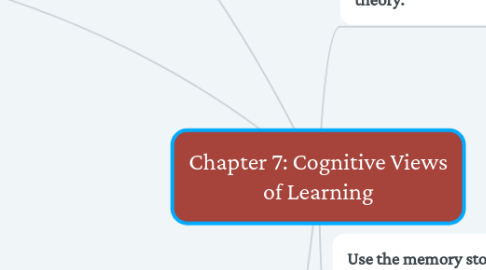
1. Describe the cognitive processes in the human memory model and identify applications in everyday events.
1.1. Cognitive processes: attention, perception, encoding, retrieval
1.1.1. Attention - process of selectively focusing on one stimulus in the environment while ignoring others
1.1.2. Perception - the process people use to find meaning in stimuli
1.1.3. Encoding - representing information in long-term memory in a way that makes sense to them
1.1.4. Retrieval - forgetting is the loss of, or inability to retrieve, information from memory
2. Define metacognition and explain how it influences learning.
2.1. Metacognition - knowledge and regulation of our cognition; "knowing about knowing"
2.1.1. "Accurate metacognition drives effective study behavior and can improve cognition without significant increases in work or effort, while inaccurate or biased metacognition may lead learaners to adopt suboptimal study behaviors and lead to inferior levels of learning".
3. Describe how information processing and the model of human memory can be applied to increase learning for all students.
3.1. Conduct reviews to activate schemas and check perceptions
3.2. Begin learning activities with attention-getting experiences
3.3. Develop learners' background knowledge with high-quality representations of content
3.4. Interact with students to promote cognitive activity and reduce cognitive load
3.5. Capitalize on meaningful encoding strategies
3.6. Model and encourage metacognition
4. Describe and explain the principles of cognitive leaning theory.
4.1. Principles of cognitive learning theory help us understand the way people of all ages think, learn, and develop.
4.2. Learning and development depend on learners' experiences.
4.2.1. Experiences provide the raw material for learning and development.
4.3. People want their experiences to make sense.
4.3.1. Helping students make sense of what we teach is one of our most important goals.
4.4. To make sense of their experiences, learners construct knowledge.
4.4.1. If the way we present information doesn't make sense to them, they will reorganize it so that it does, or memorize as much of it as they can and then quickly forget it.
4.5. Knowledge that learners construct depends on what they already know.
4.5.1. It is our job to help students acquire the background experiences they need to construct valid knowledge.
4.6. Social interaction facilitates learning.
4.6.1. Social interaction provides information, builds on others' ideas, and puts thoughts into words
5. Use the memory stores in the human memory model to explain events in the classrooms and in the everyday world.
5.1. The human memory model is composed of three major components. The first are the three memory stores.
5.1.1. Sensory Memory - information store that briefly holds incoming stimuli from the environment
5.1.2. Working Memory - conscious component; where we try to make sense of experiences by linking them to what we already know
5.1.3. Long-term Memory - permanent information store

